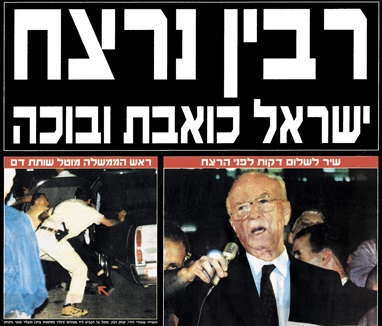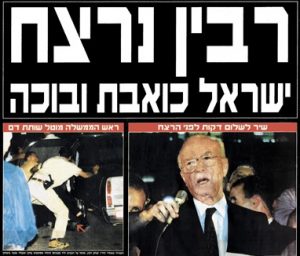Remembering Rabin

Today, 12 Heshvan, marks the 25th anniversary of the assasination of Prime Minister Yitzhak Rabin z”l (the secular date is observed on November 4th). That the assassin was a self-identifying member of the Religious Zionist community has been a source of shame and cause for self-reflection for our community this past quarter century.
Shortly after the assassination, Emanuel Feldman, then serving as the editor of TRADITION, observed:
The confessed assassin was surely concerned about the kashrut of his food, the reliability of his eruv, and the quality of his lulav. How can it be that the taking of a life or the desecration of the name of God apparently did not concern him? Who can know the answer? Only God knows the intricate machinations of the human heart, says Jeremiah (17:9-10). But that human beings can rationalize any act is evident from the incident of the strange “ish” with whom Jacob wrestled though the night. Who was he? One Talmudic view (Hullin 91a) holds that he appeared to Jacob as a heathen (ke-akum nidme lo); the other, that he appeared to him as a Torah scholar (ke-talmid hakham nidme lo). On which the Avnei Nezer famously suggests that within each person there reside two tyes of temptation: one persuades the sinner to transgress even if it is wrong (ke-akum); the other persuades the sinner that the transgression is not wrong but is in fact a mitzva (ke-talmid hakham). In our day we have moved beyond this: not only do transgressions become mitzvot, but the transgressors convince themselves that they are reincarnations of Pinhas, pure and untarnished zealots acting on behalf of God. But those who realize that they are not pure or untarnished will take this opportunity to look unflinchingly in the mirror.

See: Emanuel Feldman, “The Editor’s Notebook: Into the Looking Glass,” TRADITION 30:2 (Winter 1996).
Five years ago, with the hindsight of twenty years distance from the tragedy of 1995, Yosef Blau dissected the divergent reactions of different factions with Religious Zionism over the preceding two decades. How did different segments of the community internalize the lessons of the assassination and the incriminations which were pointed at the community, largely by the secular press and political cognoscenti? Have we learned to me more careful with the use and misuse of halakhic sources and reasoning in debating public policy?
See: Yosef Blau, “Religious Zionism and the Rabin Assassination,” TRADITION 48:4 (Winter 2015).
[Published on October 30, 2020]
